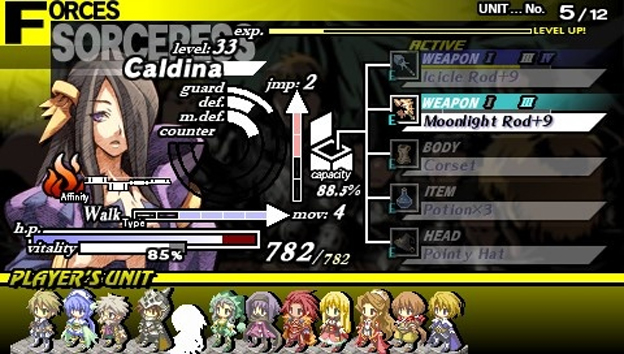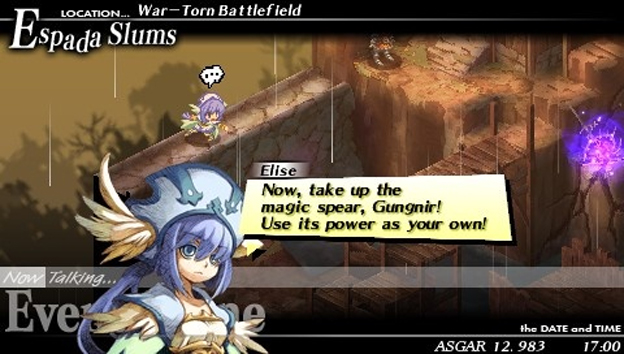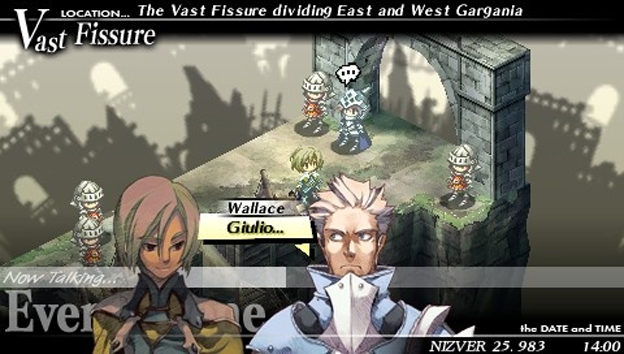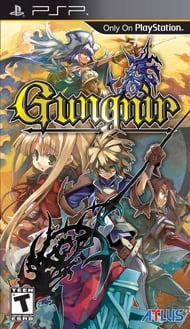A Somewhat Plodding Revolution
How far would you go in the fight against injustice? Gungnir asks that question when its young protagonist gains the powers of a demonic spear. Sadly, the game’s plodding pace, extremely linear structure, and presence on the PSP mean that it will mostly appeal to existing fans of Sting’s strategy RPGs. There are some interesting ideas in the game, but it falls short in terms of execution.
Gungnir’s story revolves around a revolution begun against the ruling government of Gargandia, a mighty empire. It seems the ruling Daltania race of Gargandia has crushed the minority Leonica race under its boot heels. The player, of course, controls a young Leonica warrior who is an important member of the Esperanza rebel group. When the young man, Giulio, is almost killed in a brutal attack by a petty minor Daltanian lord, he mysteriously comes into possession of a mystic spear that has fallen from the heavens. Giulio quickly learns that the spear gives him great powers, and seizes victory from the jaws of defeat.

The spear, Gungnir, houses a number of rather-unpleasant war deities that Giulio can call upon to aid him in battle, though they’re rather indiscriminate about whom they hurt. The attendant moral difficulties of controlling Gungnir while mounting a revolution that continually sees Giulio and his friends in the underdog position propel the story forward, though there are plenty of plot twists and side-plots along the way. The plot is quite serious, fairly interesting, and even comes with some moral decisions for the player to make. Though the decisions don’t alter the course of the linear storyline, they do lead to several possible story endings. It’s a decently interesting story, though some of the scenes drag on longer than they should, and the main action can sometimes be derailed by minor plot points that take up too much screen time.
This being a strategy RPG, the main amount of playtime is dedicated to battling. Gungnir’s battle system is fairly typical for turn-based SRPGs, with characters moving along a gridded battlefield and executing various positional attacks depending on their character class and equipped weapon.

The main twist that the game adds to this system is the addition of a timed turn order. A line of icons at the bottom of the screen tracks the turns of individual enemies and the player’s party. While each enemy has an individual turn, the player can move any desired unit during a player turn—though there’s a hit point penalty for moving a unit too soon after it has just had a turn. The player accrues tactics points while attacking, which can be used to move out of turn, buff the attacking character, or perform a multi-character attack (provided party members are suitably placed on the battlefield.)
Despite its importance to the story, Gungnir’s usefulness in battle is rather limited. The war gods kept in the spear will attack both enemies and allies randomly. The problem is that the player is usually severely outnumbered, and losing even one troop member to Gungnir’s whims can be devastating. Use it at the beginning of battle and risk being down a group member or two in battles that provide few spots for troop members in the first place. Use it near the end of battle and risk botching the entire thing with an unlucky hit. It’s far less risky and is generally sufficient to simply rely on standard weaponry to come out on top.

Gungnir aside, the basics of the system are fairly sound, but they break down when it comes to the details. Surveying the battlefield and issuing orders can be unwieldy thanks to a somewhat clumsy interface. It’s particularly difficult to work with battlefields that are on multiple levels or contain major terrain height differences. The turn order system also falls a bit flat, especially as the player’s party is heavily outnumbered, so much of the battle is spent watching enemy troops shuffle about. Add enemies that take several turns each to kill and the battles become very long, frequently lasting an hour or more. The game can’t be saved in battle, either, making it quite inconvenient to play on the go or in short bursts.
With the storyline and battles covered, that’s pretty much all there is to Gungnir. Story scenes lead into battles, with only a short break to buy equipment, craft weapon upgrades, and recruit troops in between. There are no optional battles or explorable areas in Gungnir, and thus no opportunities to grind up levels for troops that are getting behind, other than failing and replaying one of the lengthy main battles. In this way, Gungnir practically requires the player to use only a small portion of the available troops, and battle often feels like an exercise in attempting to garner as much experience as possible for the lowest-level troops rather than strategically planning the best route to victory.

There’s not much to say about Gungnir’s audiovisuals. The battle screens and interface are generally serviceable, though not particularly stylish. The character portraits, seen in the traditional Japanese “talking head” conversations, are attractive, but seem off in several ways. There’s not a wide enough range of emotions displayed on the characters’ faces, meaning that character expressions don’t always match the tone of the conversation. Most of the characters also look far too clean and shiny for the situations they’re in, particularly the supposedly impoverished rebels. Gungnir’s music does a better job of conveying the game’s atmosphere than the graphics do, with suitably serious and grandiose tracks.
Although Gungnir’s campaign will take a while to play through, that’s solely due to the artificially lengthy battles. Though there are several possible endings based on the choices Giulio makes, I suspect most players won’t have the patience to go through the exact same campaign a second time.
For some, Gungnir might be a game that has been helpfully stripped down to the basics, with no extraneous frills to artificially extend gameplay. For others, it will feel like a barebones effort with some problematic aspects to its battle system. Your mileage will vary based on how much you enjoy the kind of challenge Gungnir provides and how much patience you have for the battles. In general, I’d call Gungnir a fairly average example of the strategy RPG genre. It’ll scratch the itch of hardcore strategy fans, but there’s not a ton to miss by skipping it, either.
RATING OUT OF 5 RATING DESCRIPTION 3.4 Graphics
The graphics are serviceable and the character designs look nice, though some will find them unsuited to the game’s themes and content. 2.5 Control
Gungnir’s cramped battlefields can be difficult to navigate, especially when they feature multiple levels. 3.5 Music / Sound FX / Voice Acting
The game’s music conveys its atmosphere better than its graphics. 3.4 Play Value
There are multiple endings based on player choices, but the journey itself never changes and contains no optional activities. 3.4 Overall Rating – Fair
Not an average. See Rating legend below for a final score breakdown.
| Review Rating Legend | |||
|---|---|---|---|
| 0.1 – 1.9 = Avoid | 2.5 – 2.9 = Average | 3.5 – 3.9 = Good | 4.5 – 4.9 = Must Buy |
| 2.0 – 2.4 = Poor | 3.0 – 3.4 = Fair | 4.0 – 4.4 = Great | 5.0 = The Best |
Game Features:
